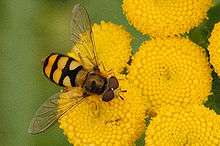Eupeodes latifasciatus
Eupeodes latifasciatus is a species of hoverfly. Adults feed on nectar; larvae feed on aphids and scale insects.[1]
| Eupeodes latifasciatus | |
|---|---|
 | |
| Eupeodes latifasciatus male | |
| Scientific classification | |
| Kingdom: | |
| Phylum: | |
| Class: | |
| Order: | |
| Family: | |
| Subfamily: | |
| Tribe: | |
| Genus: | |
| Subgenus: | Metasyrphus |
| Species: | E. latifasciatus |
| Binomial name | |
| Eupeodes latifasciatus (Macquart, 1829) | |
| Synonyms | |
| |
Description
- For terms see Morphology of Diptera
Wing length 6·5-8 ·5 mm. Male:Yellow spots of tergites 3 and 4 connected. Front margin of yellow spots almost straight, parallel with front margin of tergite. Scutellum mainly yellow haired on disc.Female: No frontal dust spots, frons entirely shiny. Lateral margins of tergite 5 yellow. Yellow spots of tergites 3 and 4 joined as bands reaching lateral margins.[2][3][4][5] The male genitalia are figured by Dusek and Laska (1976).[6] The larva is described by Dusek & Laska (1960).[7]
Distribution
Palaearctic Fennoscandia South to Iberia and the Mediterranean basin. Turkey, Ireland eastwards through Europe to European Russia, the Russian Far East, Siberia to the Pacific coast (Sakhalin and Kuril Isles), India, Nearctic from Alaska south to California and Texas.[8][9]
Biology
Habitat: Wetland and open ground; fen, humid, grassland, and along streams in open country, unsown fallow land.[10] Flowers visited include white umbellifers, Caltha, Convolvulus, Euphorbia, Prunus padus, Ranunculus, Salix repens, Taraxacum, Tussilago, Ulex.[11] The flight period is May to September (April to October in southern Europe).
References
- Stubbs, Alan E.; Falk, Steven J. (1983). British Hoverflies: An Illustrated Identification Guide. British Entomological & Natural History Society. p. 253, xvpp.
- Van Veen, M. (2004) Hoverflies of Northwest Europe: identification keys to the Syrphidae. 256pp. KNNV Publishing, Utrecht.addendum
- Van der Goot,V.S. (1981) De zweefvliegen van Noordwest - Europa en Europees Rusland, in het bijzonder van de Benelux. KNNV, Uitgave no.32: 275pp. Amsterdam.
- Bei-Bienko, G.Y. & Steyskal, G.C. (1988) Keys to the Insects of the European Part of the USSR, Volume V: Diptera and Siphonaptera, Part I. Amerind Publishing Co., New Delhi. ISBN 81-205-0080-6.
- Coe, R.L. (1953) Diptera: Syrphidae. Handbks.ident.Br.insects, 10(1): 1-98. R.ent.Soc.London. pdf
- Dusek, J. & Laska, P. (1976) European species of Metasyrphus: key, descriptions and notes.Acta ent. bohemoslov., 73: 263 - 282.
- Dusek, J. & Laska P. (1960) Beitrag zur Kenntnis der Schwebfliegen-Larven II. Prirod. cas.slezsky, 21: 299-320 and Weitere unbekannte Syrphidenlarven (Diptera, Syrphidae). Acta Soc. ent. Cechosloveniae, 57: 371-388.
- Fauna Europaea
- Peck, L.V. (1988) Syrphidae. In: Soos, A. & Papp, L. (eds.) Catalogue of Palaearctic Diptera, 8: 11-230. Akad.Kiado, Budapest.
- Speight, M.C.D. (2011). "Species accounts of European Syrphidae (Diptera)" (PDF). Syrph the Net, the database of European Syrphidae. 65: 285pp.
- de Buck, N. (1990) Bloembezoek en bestuivingsecologie van Zweefvliegen (Diptera, Syrphidae) in het bijzonder voor België. Doc.Trav. IRSNB, no.60, 1-167.
External links
- Images at Barcode of Life Data Systems (BOLD)